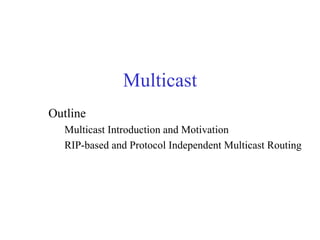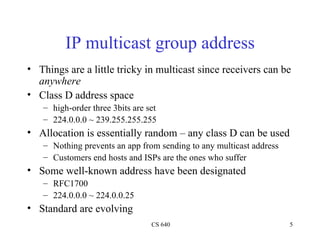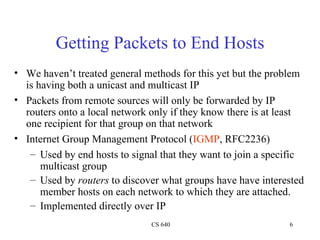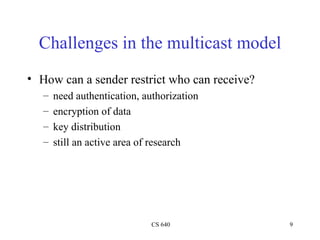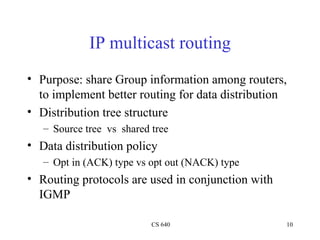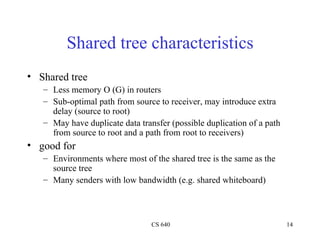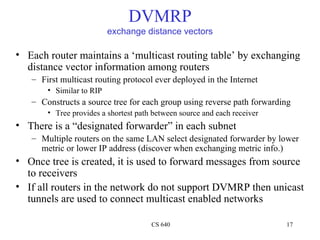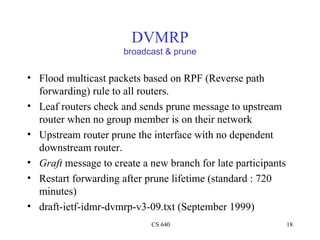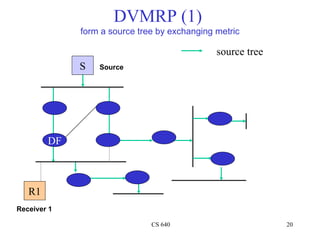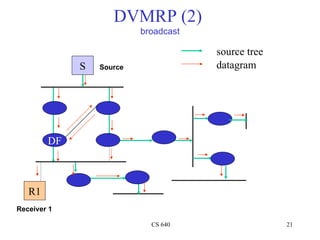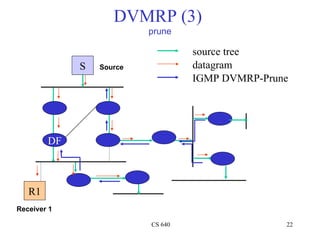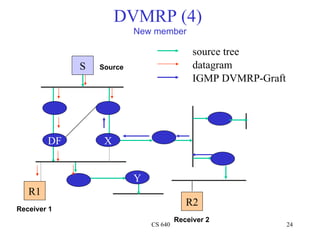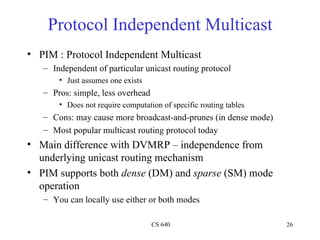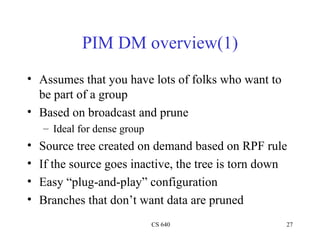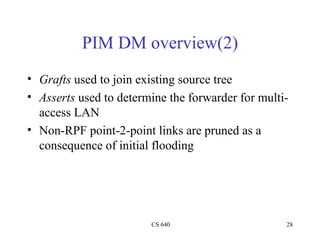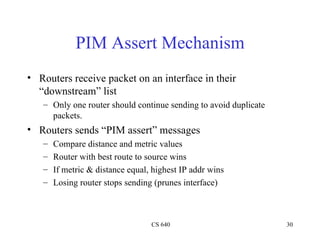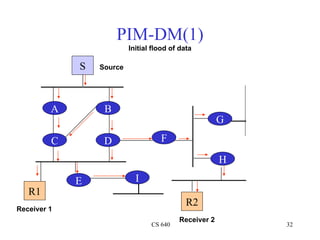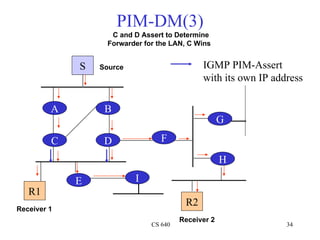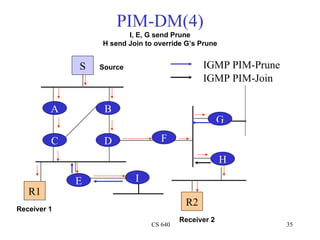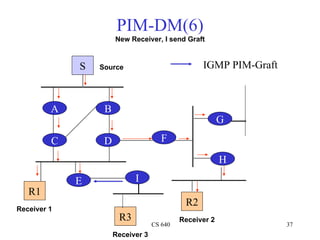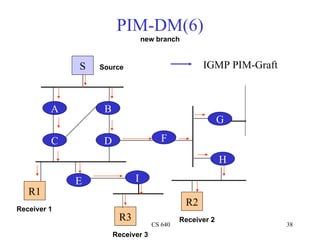Multicast
- 1. Multicast Outline Multicast Introduction and Motivation RIP-based and Protocol Independent Multicast Routing
- 2. One to many communication • Application level one to • IP multicast many communication • multiple unicasts R R S S R R R R CS 640 2
- 3. Why Multicast • When sending same data to multiple receivers – better bandwidth utilization – less host/router processing – quicker participation • Application – Video/Audio broadcast (One sender) – Video conferencing (Many senders) – Real time news distribution – Interactive gaming CS 640 3
- 4. IP multicast service model • Invented by Steve Deering (PhD. 1991) – It’s a different way of routing datagrams • RFC1112 : Host Extensions for IP Multicasting - 1989 • Senders transmit IP datagrams to a "host group" • “Host group” identified by a class D IP address • Members of host group could be present anywhere in the Internet • Members join and leave the group and indicate this to the routers • Senders and receivers are distinct: i.e., a sender need not be a member • Routers listen to all multicast addresses and use multicast routing protocols to manage groups CS 640 4
- 5. IP multicast group address • Things are a little tricky in multicast since receivers can be anywhere • Class D address space – high-order three 3bits are set – 224.0.0.0 ~ 239.255.255.255 • Allocation is essentially random – any class D can be used – Nothing prevents an app from sending to any multicast address – Customers end hosts and ISPs are the ones who suffer • Some well-known address have been designated – RFC1700 – 224.0.0.0 ~ 224.0.0.25 • Standard are evolving CS 640 5
- 6. Getting Packets to End Hosts • We haven’t treated general methods for this yet but the problem is having both a unicast and multicast IP • Packets from remote sources will only be forwarded by IP routers onto a local network only if they know there is at least one recipient for that group on that network • Internet Group Management Protocol (IGMP, RFC2236) – Used by end hosts to signal that they want to join a specific multicast group – Used by routers to discover what groups have have interested member hosts on each network to which they are attached. – Implemented directly over IP CS 640 6
- 7. IGMP – Joining a group Example : R joins to Group 224.2.0.1 IGMP Membership-Report • R sends IGMP Membership-Report R to 224.2.0.1 Network A • DR receives it. DR will start forwarding packets for 224.2.0.1 to Network A DR Network B Data to 224.2.0.1 • DR periodically sends IGMP Membership-Query to 224.0.0.1 (ALL-SYSTEMS.MCAST.NET) R: Receiver DR: Designated Router • R answers IGMP Membership- Report to 224.2.0.1 CS 640 7
- 8. IGMP – Leaving a group IGMP Leave-Group Example : R leaves from a Group 224.2.0.1 R • R sends IGMP Leave-Group to 224.0.0.2 Network A (ALL-ROUTERS.MCAST.NET) • DR receives it. DR • DR stops forwarding packets for Network B Data to 224.2.0.1 224.2.0.1 to Network A if no more 224.2.0.1 group members on Network R: Receiver DR: Designated Router A. CS 640 8
- 9. Challenges in the multicast model • How can a sender restrict who can receive? – need authentication, authorization – encryption of data – key distribution – still an active area of research CS 640 9
- 10. IP multicast routing • Purpose: share Group information among routers, to implement better routing for data distribution • Distribution tree structure – Source tree vs shared tree • Data distribution policy – Opt in (ACK) type vs opt out (NACK) type • Routing protocols are used in conjunction with IGMP CS 640 10
- 11. Source distribution tree Source S Notation: (S, G) S = Source G = Group A B D F C E R R Receiver 1 Receiver 2 CS 640 11
- 12. Shared distribution tree Source S1 Notation: (*, G) * = all sources G = Group Shared Root A B D F S2 C E R R Receiver 1 Receiver 2 CS 640 12
- 13. Source tree characteristics • Source tree – More memory O (G x S ) in routers – optimal path from source to receiver, minimizes delay • good for – small number of senders, many receivers such as Radio broadcasting application CS 640 13
- 14. Shared tree characteristics • Shared tree – Less memory O (G) in routers – Sub-optimal path from source to receiver, may introduce extra delay (source to root) – May have duplicate data transfer (possible duplication of a path from source to root and a path from root to receivers) • good for – Environments where most of the shared tree is the same as the source tree – Many senders with low bandwidth (e.g. shared whiteboard) CS 640 14
- 15. Data distribution policy • Opt out (NACK) type – Start with “broadcasting” then prune brunches with no receivers, to create a distribution tree – Lots of wasted traffic when there are only a few receivers and they are spread over wide area • Opt in (ACK) type – Forward only to the hosts which explicitly joined to the group – Latency of join propagation CS 640 15
- 16. Protocol types • Dense mode protocols – assumes dense group membership – Source distribution tree and NACK type – DVMRP (Distance Vector Multicast Routing Protocol) – PIM-DM (Protocol Independent Multicast, Dense Mode) – Example: Company-wide announcement • Sparse mode protocol – assumes sparse group membership – Shared distribution tree and ACK type – PIM-SM (Protocol Independent Multicast, Sparse Mode) – Examples: Futurama or a Shuttle Launch CS 640 16
- 17. DVMRP exchange distance vectors • Each router maintains a ‘multicast routing table’ by exchanging distance vector information among routers – First multicast routing protocol ever deployed in the Internet • Similar to RIP – Constructs a source tree for each group using reverse path forwarding • Tree provides a shortest path between source and each receiver • There is a “designated forwarder” in each subnet – Multiple routers on the same LAN select designated forwarder by lower metric or lower IP address (discover when exchanging metric info.) • Once tree is created, it is used to forward messages from source to receivers • If all routers in the network do not support DVMRP then unicast tunnels are used to connect multicast enabled networks CS 640 17
- 18. DVMRP broadcast & prune • Flood multicast packets based on RPF (Reverse path forwarding) rule to all routers. • Leaf routers check and sends prune message to upstream router when no group member is on their network • Upstream router prune the interface with no dependent downstream router. • Graft message to create a new branch for late participants • Restart forwarding after prune lifetime (standard : 720 minutes) • draft-ietf-idmr-dvmrp-v3-09.txt (September 1999) CS 640 18
- 19. RPF(reverse path forwarding) • Simple algorithm developed to avoid duplicate packets on multi- access links • RPF algorithm takes advantage of the IP routing table to compute a multicast tree for each source. • RPF check – When a multicast packet is received, note its source (S) and interface (I) – If I belongs to the shortest path from S, forward to all interfaces except I – If test in step 2 is false, drop the packet • Packet is never forwarded back out the RPF interface! CS 640 19
- 20. DVMRP (1) form a source tree by exchanging metric source tree S Source DF R1 Receiver 1 CS 640 20
- 21. DVMRP (2) broadcast source tree S Source datagram DF R1 Receiver 1 CS 640 21
- 22. DVMRP (3) prune source tree S Source datagram IGMP DVMRP-Prune DF R1 Receiver 1 CS 640 22
- 23. DVMRP (4) X and Y pruned source tree S Source datagram DF X Y R1 Receiver 1 CS 640 23
- 24. DVMRP (4) New member source tree S Source datagram IGMP DVMRP-Graft DF X Y R1 R2 Receiver 1 Receiver 2 CS 640 24
- 25. DVMRP (4) New branch source tree S Source datagram IGMP DVMRP-Graft DF X Y R1 R2 Receiver 1 Receiver 2 CS 640 25
- 26. Protocol Independent Multicast • PIM : Protocol Independent Multicast – Independent of particular unicast routing protocol • Just assumes one exists – Pros: simple, less overhead • Does not require computation of specific routing tables – Cons: may cause more broadcast-and-prunes (in dense mode) – Most popular multicast routing protocol today • Main difference with DVMRP – independence from underlying unicast routing mechanism • PIM supports both dense (DM) and sparse (SM) mode operation – You can locally use either or both modes CS 640 26
- 27. PIM DM overview(1) • Assumes that you have lots of folks who want to be part of a group • Based on broadcast and prune – Ideal for dense group • Source tree created on demand based on RPF rule • If the source goes inactive, the tree is torn down • Easy “plug-and-play” configuration • Branches that don’t want data are pruned CS 640 27
- 28. PIM DM overview(2) • Grafts used to join existing source tree • Asserts used to determine the forwarder for multi- access LAN • Non-RPF point-2-point links are pruned as a consequence of initial flooding CS 640 28
- 29. PIM DM Forwarding • PIM DM interfaces are placed on an “downstream” list for a multicast group if: – PIM neighbor is heard on interface – Host on this interface has just joined the group – Interface has been manually configured to join group • Packets are flooded out all interfaces in “downstream” list – If a PIM neighbor is present, DM assumes EVERYONE wants to receive the group so it gets flooded to that link CS 640 29
- 30. PIM Assert Mechanism • Routers receive packet on an interface in their “downstream” list – Only one router should continue sending to avoid duplicate packets. • Routers sends “PIM assert” messages – Compare distance and metric values – Router with best route to source wins – If metric & distance equal, highest IP addr wins – Losing router stops sending (prunes interface) CS 640 30
- 31. PIM DM State Maintenace • State is maintained by the “flood and prune” behavior of Dense Mode. – Received Multicast packets reset(S,G) entry “expiration” timers. – When (S,G) entry “expiration” timers count down to zero, the entry is deleted. • Interface prune state times out causing periodic reflooding and pruning – could be as little as 210 seconds CS 640 31
- 32. PIM-DM(1) Initial flood of data S Source A B G C D F H E I R1 R2 Receiver 1 Receiver 2 CS 640 32
- 33. PIM-DM(2) prune non-RPF p2p link S Source IGMP PIM-Prune A B G C D F H E I R1 R2 Receiver 1 Receiver 2 CS 640 33
- 34. PIM-DM(3) C and D Assert to Determine Forwarder for the LAN, C Wins S Source IGMP PIM-Assert with its own IP address A B G C D F H E I R1 R2 Receiver 1 Receiver 2 CS 640 34
- 35. PIM-DM(4) I, E, G send Prune H send Join to override G’s Prune S Source IGMP PIM-Prune IGMP PIM-Join A B G C D F H E I R1 R2 Receiver 1 Receiver 2 CS 640 35
- 36. PIM-DM(5) I Gets Pruned E’s Prune is Ignored (since R1 is a receiver) G’s Prune is Overridden (due to new receiver R2) S Source A B G C D F H E I R1 R2 Receiver 1 Receiver 2 CS 640 36
- 37. PIM-DM(6) New Receiver, I send Graft S Source IGMP PIM-Graft A B G C D F H E I R1 R2 Receiver 1 R3 Receiver 2 CS 640 37 Receiver 3
- 38. PIM-DM(6) new branch S Source IGMP PIM-Graft A B G C D F H E I R1 R2 Receiver 1 R3 Receiver 2 CS 640 38 Receiver 3

